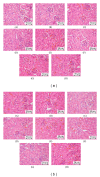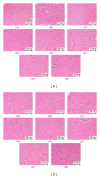Acute toxicity study of zerumbone-loaded nanostructured lipid carrier on BALB/c mice model
- PMID: 25276798
- PMCID: PMC4172924
- DOI: 10.1155/2014/563930
Acute toxicity study of zerumbone-loaded nanostructured lipid carrier on BALB/c mice model
Abstract
Zerumbone- (ZER-) loaded nanostructure lipid carrier (NLC) (ZER-NLC) prepared for its antileukemia effect in vitro was evaluated for its toxicological effects by observing changes in the liver, kidney, spleen, lung, heart, and brain tissues, serum biochemical parameters, total haemogram, and bone marrow stem cells. The acute toxicity study for ZER-NLC was conducted by orally treating BALB/c mice with a single dose with either water, olive oil, ZER, NLC, or ZER-NLC for 14 days. The animals were observed for clinical and behavioral abnormalities, toxicological symptoms, feed consumption, and gross appearance. The liver, kidney, heart, lung, spleen, and brain tissues were assessed histologically. Total haemogram was counted by hemocytometry and microhematocrit reader. Bone marrow examination in terms of cellular morphology was done by Wright staining with bone marrow smear. Furthermore, serum biochemical parameters were determined spectrophotometrically. Grossly all treated mice, their investigated tissues, serum biochemical parameters, total haemogram, and bone marrow were normal. At oral doses of 100 and 200 mg/kg ZER-NLC there was no sign of toxicity or mortality in BALB/c mice. This study suggests that the 50% lethal dose (LD50) of ZER-NLC is higher than 200 mg/kg, thus, safe by oral administration.
Figures








References
-
- Balakrishnan RK, Radzan RK, Bhattacharyya SC. Oil of Zingiber zerumbet Smith. Part 1. Isolation of various constituents and characterization of the inonocyclic ketone zerumbone. Perfumery Essential Oil Record. 1956;47:274–279.
-
- Riyanto S. Phytochemical Studies and Bioactivity Tests of Murraya paniculata Jack, Aegle marmelos Correa and Zingiber amaricans Blume. Universiti Putra Malaysia; 2003.
-
- Chemical composition and cytotoxic activity of the essential oil of Zingiber ottensii . Proceedings of the III WOCMAP Congress on Medicinal and Aromatic Plants—Volume 1: Bioprospecting and Ethnopharmacology; 2003; p. p. 675.
-
- Kishore N, Dwivedi RS. Zerumbone: a potential fungitoxic agent isolated from Zingiber cassumunar Roxb. Mycopathologia. 1992;120(3):155–159.
-
- Muhammad AMS. A Study on Microwave-Assisted Extraction of Zingiber aromaticum. Faculty of Chemical & Natural Resources Engineering; 2009.
Publication types
MeSH terms
Substances
LinkOut - more resources
Full Text Sources
Other Literature Sources

